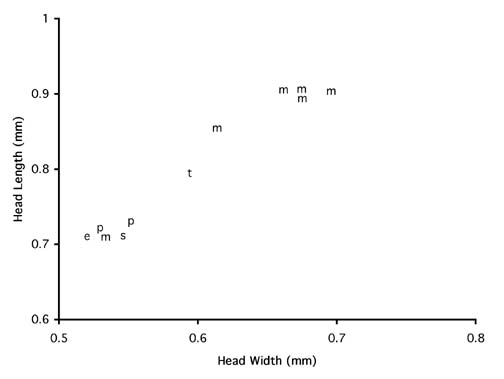Ponerinae, Formicidae, Hymenoptera, Insecta, Arthropoda, Animalia
Additional images:
Worker,
eye and side view of head
(small,
large);
sem of face
(large,
small);
mandible
(large,
small);
clypeus
(large,
small);
eye and lateral view of head
(large,
small);
lateral view
(small,
large);
mesosoma, lateral view
(large,
small;
line drawing of face
(large,
small).
Range
Costa Rica: mountainous regions above 1000m.
Identification
Mandible with two apical teeth and large basal tooth, basal tooth relatively sharp (unlike JTL-003); anteromedian clypeal border triangular, strongly projecting, without spine; eye relatively small (unlike oculata); sculpture on face composed of puncta and short transverse rugae (unlike JTL-001, paeminosa); head relatively narrow, head width/head length less than 0.8.
Similar species: oculata.
Natural History
All Simopelta species are nomadic group raiders, convergent with Ecitoninae. See additional information under genus account.
I know this species from 15 separate collections, making it one of the more commonly encountered. It occurs above 800m in the Peľas Blancas Valley and Monteverde cloud forest. I have also seen collections from 700m at Pitilla Biological Station in the Cordillera de Guanacaste, from 1000-1500m elevation in Braulio Carrillo National Park, and at 1200m in Wilson Botanical Garden near San Vito. In Monteverde, I have observed columns foraging high on the Chomogo trail, on cold rainy days. I also observed a column of this species high in the canopy of a cloud forest tree.
Selected Records
JTL15Feb82/1300: Traveling in short columns across the surface of a moss mat. I initially disturbed them, then watched for about one hour. The columns seemed to move back and forth over roughly the same path, disappearing at both ends into the epiphytes. I saw only two ants carrying anything: small hairy larvae; both collected. Afterwards I dug through the epiphytes, but I could find no central nest or brood, just scattered workers. [I cannot locate the "small hairy larvae."]
JTL1991: Cloud forest on ridge crest, juncture of Nuboso and Brillante trails. Simopelta with Pheidole boruca prey; diffuse raiding party on and in moss/soil interface, on ground in treefall gap. Stray Pheidole boruca workers seen in area carrying brood.
Comments
This species shows a bimodal distribution of morphology (Figure 1). Some workers are larger, with relatively longer scapes, and the dorsal face of the propodeum is irregularly rugose. Some workers are smaller, with relatively shorter scapes, and the dorsal face of the propodeum is partially smooth and shining. There is a tendency for the collections of smaller workers to be found at lower elevations and more often in Winkler samples. However, there are intermediates. I prefer to consider them a single morphospecies for now.

Figure 1. Scatterplot of head width vs. head length for Simopelta workers. Each point is from a different colony. Head width is maximum width of head in full-face view not including eyes. Head length is maximum length including anteromedian projection of clypeus. Localities are represented by letters: e, 700m in Cordillera de Guanacaste; p, 800-900m in Peľas Blancas Valley; m, 1400-1600m in Monteverde; s, 1100m site on Barva transect in Braulio Carrillo National Park; t, 1500m site on Barva transect. A plot of scape length vs. head length has the same pattern.
Page author:
John T. Longino, The Evergreen State College, Olympia WA 98505 USA. longinoj@evergreen.edu
Last modified: 5 April 2009.